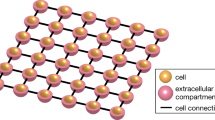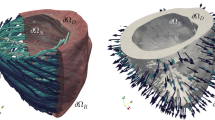Abstract
Cardiac and neural systems share common features of intrinsic oscillation in some cells as well as the ability to propagate excitation. One theoretical approach to study such systems is to develop realistic models for the tissue. This involves first developing detailed ionic “Hodgkin–Huxley”-type models of individual cells and then connecting the individual cells via synaptic and gap junctions in realistic geometries. An alternative approach is to characterize tissue in terms of functional properties such as phase resetting curves and restitution curves. Using simple models based on one-dimensional difference equations, the measured functional curves can be used to predict, analyze, and interpret nonlinear dynamical phenomena. This approach offers the prospects of providing simplified descriptions that offer insight into the experimental and clinical cardiac dynamics.







Similar content being viewed by others
Notes
Neuroscience papers generally use the term Type 1, but since we have used “Type” to characterize topology, we use “Class” to distinguish unimodal and bimodal resetting curves.
References
Arnol’d VI (1965) Small denominators. I. Mappings of the circumference onto itself. Transl Am Math Soc 46:213–284
Arnold VI, Levi M (1983) Geometrical methods in the theory of ordinary differential equations, vol 18. Springer, New York
Billette J (1976) Preceding His-atrial interval as a determinant of atrioventricular nodal conduction time in the human and rabbit heart. Am J Cardiol 38(7):889–896
Cherry EM, Fenton FH (2004) Suppression of alternans and conduction blocks despite steep APD restitution: electrotonic, memory, and conduction velocity restitution effects. Am J Physiol Heart C 286(6):H2332–H2341
Constantino J, Hu Y, Trayanova NA (2012) A computational approach to understanding the cardiac electromechanical activation sequence in the normal and failing heart, with translation to the clinical practice of CRT. Prog Biophys Mol Biol 110(2–3):372–379
Costantini O, Hohnloser SH, Kirk MM, Lerman BB, Baker JH, Sethuraman B, Dettmer MM, Rosenbaum DS (2009) The ABCD (Alternans Before Cardioverter Defibrillator) trial strategies using T-wave alternans to improve efficiency of sudden cardiac death prevention. J Am Coll Cardiol 53(6):471–479
Courtemanche M, Glass L, Keener JP (1993) Instabilities of a propagating pulse in a ring of excitable media. Phys Rev Lett 70(14):2182
Decherd GM, Ruskin A (1946) The mechanism of the Wenckebach type of AV block. Br Heart J 8(1):6
Eliasmith C, Stewart TC, Choo X, Bekolay T, DeWolf T, Tang C, Rasmussen D (2012) A large-scale model of the functioning brain. Science 338(6111):1202–1205
Ermentrout GB, Glass L, Oldeman BE (2012) The shape of phase-resetting curves in oscillators with a saddle node on an invariant circle bifurcation. Neural Comput 24(12):3111–3125
Feigenbaum MJ (1978) Quantitative universality for a class of nonlinear transformations. J Stat Phys 19(1):25–52
Fenton F, Karma A (1998) Vortex dynamics in three-dimensional continuous myocardium with fiber rotation: filament instability and fibrillation. Chaos 8(1):20–47
Glass L, Guevara MR, Bélair J, Shrier A (1984) Global bifurcations of a periodically forced biological oscillator. Phys Rev A 29(3):1348–1357
Glass L, Guevara MR, Shrier A (1987) Universal bifurcations and the classification of cardiac arrhythmias. Ann NY Acad Sci 504(1):168–178
Glass L, Mackey MC (1988) From clocks to chaos: the rhythms of life. Princeton University Press, Princeton
Glass L, Sun J (1994) Periodic forcing of a limit-cycle oscillator: fixed points, Arnold tongues, and the global organization of bifurcations. Phys Rev E 50(6):5077–5084
González H, Arce H, Guevara MR (2008) Phase resetting, phase locking, and bistability in the periodically driven saline oscillator: experiment and model. Phys Rev E 78(3):036217 (13 pages)
Guevara MR (1991) Iteration of the human atrioventricular (AV) nodal recovery curve predicts many rhythms of AV block. In: Theory of heart. Springer, Berlin, pp 313–358
Guevara MR, Glass L (1982) Phase locking, periodic doubling bifurcations and chaos in a mathematical model of a periodically driven oscillator: a theory for the entrainment of biological oscillators and the generation of cardiac dysrhythmias. J Math Biol 14:1–23
Guevara MR, Glass L, Shrier A (1981) Phase locking, period-doubling bifurcations, and irregular dynamics in periodically stimulated cardiac cells. Science 214:1350–1353
Guevara MR, Ward G, Shrier A, Glass L (1984) Electrical alternans and period-doubling bifurcations. In: IEEE computers in cardiology. IEEE Computer Society Press, Los Alamitos, CA, pp 167–170
Hoppensteadt F, Keener JP (1982) Phase locking of biological clocks. J Math Biol 15(3):339–349
Hunter P, Chapman T, Coveney PV, De Bono B, Diaz V, Fenner J, Frangi AF, Harris P, Hose R, Kohl P et al (2013) A vision and strategy for the virtual physiological human: 2012 update. Interface Focus 3:20130004 (11 pages)
Izhikevich EM (2007) Dynamical systems in neuroscience. MIT Press, Cambridge, MA
Karma A (1994) Electrical alternans and spiral wave breakup in cardiac tissue. Chaos 4:461–472
Keener JP (1981) On cardiac arrythmias: AV conduction block. J Math Biol 12(2):215–225
Keener JP, Glass L (1984) Global bifurcations of a periodically forced nonlinear oscillator. J Math Biol 21(2):175–190
Keller E (1967) A mathematical description of biological clocks. Biosystems 1(4):279–284
Krogh-Madsen T, Butera R, Ermentrout GB, Glass L (2012) Phase resetting neural oscillators: topological theory versus the real world. In: Phase response curves in neuroscience. Springer, Berlin, pp 33–51
Landahl H, Griffeath D (1971) A mathematical model for first degree block and the Wenckebach phenomenon. Bull Math Biophys 33(1):27–38
Levinson N (1949) A second order differential equation with singular solutions. Ann Math 50(1):127–153
Levy MN, Martin PJ, Edelstein J, Goldberg LB (1974) The AV nodal Wenckebach phenomenon as a positive feedback mechanism. Prog Cardiovasc Dis 16:601–613
Li TY, Yorke JA (1975) Period three implies chaos. Am Math Mon 82(10):985–992
Mandelbrot BB (1983) The fractal geometry of nature. Macmillan, New York
May RM (1976) Simple mathematical models with very complicated dynamics. Nature 261:459–467
Mines GK (1913) On dynamic equilibrium in the heart. J Physiol 46:350–383
Mirollo RE, Strogatz SH (1990) Synchronization of pulse-coupled biological oscillators. SIAM J Appl Math 50(6):1645–1662
Nolasco JB, Dahlen RW (1968) A graphic method for the study of alternation in the cardiac action potentials. J Appl Physiol 25:191–196
Pavlidis T (1967) A model for circadian clocks. Bull Math Biol 29(4):781–791
Pavlidis T (1973) Biological oscillators: their mathematical analysis. Academic Press, London
Perkel DH, Schulman JH, Bullock TH, Moore GP, Segundo JP (1964) Pacemaker neurons: effects of regularly spaced synaptic input. Science 145(3627):61–63
Pittendrigh CS (1960) Circadian rhythms and the circadian organization of living systems. In: Cold Spring Harbor symposia on quantitative biology, vol 25. Cold Spring Harbor Laboratory Press, New York, pp 159–184
Purcell O, Jain B, Karr JR, Covert MW, Lu TK (2013) Towards a whole-cell modeling approach for synthetic biology. Chaos 23(2):025112 (8 pages)
Qu Z, Garfinkel A, Chen PS, Weiss JN (2000) Mechanisms of discordant alternans and induction of reentry in simulated cardiac tissue. Circulation 102(14):1664–1670
Qu Z, Xie Y, Garfinkel A, Weiss JN (2010) T-wave alternans and arrhythmogenesis in cardiac diseases. Front Physiol 154 (15 pages)
Reimann MW, Anastassiou CA, Perin R, Hill SL, Markram H, Koch C (2013) A biophysically detailed model of neocortical local field potentials predicts the critical role of active membrane currents. Neuron 79(2):375–390
Rinzel J, Ermentrout GB (1998) Analysis of neural excitability and oscillations. Methods Neuronal Model 2:251–292
Ritzenberg AL, Adam DR, Cohen RJ (1984) Period multupling-evidence for nonlinear behaviour of the canine heart. Nature 307:159–161
Rosenbaum DS, Albrecht P, Cohen RJ (1996) Predicting sudden cardiac death from T wave alternans on the surface electrogram. J Cardiovasc Electrophysiol 7:1095–1111
Rosenbaum DS, Jackson LE, Smith JM, Garan H, Ruskin JN, Cohen RJ (1994) Electrical alternans and vulnerability to ventricular arrhythmias. N Engl J Med 330:235–241
Schultheiss NW, Prinz AA, Butera RJ (2011) Phase response curves in neuroscience: theory, experiment, and analysis. Springer, Berlin
Shrier A, Dubarsky H, Rosengarten M, Guevara M, Nattel S, Glass L (1987) Prediction of complex atrioventricular conduction rhythms in humans with use of the atrioventricular nodal recovery curve. Circulation 76(6):1196–1205
Smaill BH, Hunter PJ (2010) Computer modeling of electrical activation: from cellular dynamics to the whole heart. In: Cardiac electrophysiology methods and models. Springer, Berlin, pp 159–185
Sun J, Amellal F, Glass L, Billette J (1995) Alternans and period-doubling bifurcations in atrioventricular nodal conduction. J Theor Biol 173(1):79–91
Talajic M, Papadatos D, Villemaire C, Glass L, Nattel S (1991) A unified model of atrioventricular nodal conduction predicts dynamic changes in Wenckebach periodicity. Circ Res 68(5):1280–1293
Toal SC, Farid TA, Selvaraj R, Chauhan VS, Masse S, Ivanov J, Harris L, Downar E, Franz MR, Nanthakumar K (2009) Short-term memory and restitution during ventricular fibrillation in human hearts: an in vivo study. Circ Arrhythm Electrophysiol 2(5):562–570
Tolkacheva E, Schaeffer D, Gauthier DJ, Krassowska W (2003) Condition for alternans and stability of the 1:1 response pattern in a “memory” model of paced cardiac dynamics. Phys Rev E 67(3):031904 (10 pages)
Wanzhen Z, Glass L, Shrier A (1992) The topology of phase response curves induced by single and paired stimuli in spontaneously oscillating chick heart cell aggregates. J Biol Rhythm 7(2):89–104
Wever R (1960) Possibilities of phase-control, demonstrated by an electronic model. In: Cold Spring Harbor symposia on quantitative biology, vol 25. Cold Spring Harbor Laboratory Press, New York, pp 197–206
Winfree AT (1970) Integrated view of resetting a circadian clock. J Theor Biol 28(3):327–374
Winfree AT (2000) The geometry of biological time, 2nd edn. Springer, New York
Zeng W, Glass L, Shrier A (1991) Evolution of rhythms during periodic stimulation of embryonic chick heart cell aggregates. Circ Res 69(4):1022–1033
Acknowledgments
We thank NSERC, the Canadian Heart and Stroke Foundation, and CIHR for financial support. We thank M. R. Guevara for helpful comments, and also for the insightful contributions he made to the development of the ideas presented here.
Author information
Authors and Affiliations
Corresponding author
Rights and permissions
About this article
Cite this article
Glass, L., Shrier, A. Functional Characterization of Oscillatory and Excitable Media. Bull Math Biol 77, 782–795 (2015). https://doi.org/10.1007/s11538-014-0015-y
Received:
Accepted:
Published:
Issue Date:
DOI: https://doi.org/10.1007/s11538-014-0015-y




